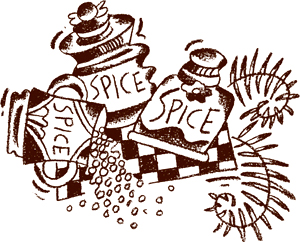
Man doesn’t live by beer alone, or for that matter by beer-can chicken alone. Sure, beer-can chicken and its variations will amaze your guests and boost your reputation as a grill master, but there comes a time when you’ll want to show off some other outlandish grilling techniques. Which brings us to this chapter of recipes that don’t happen to require beer cans. Make Welder’s Chicken, which involves roasting a fowl swaddled in aluminum foil on the grill and using welder’s gloves to turn it. Or spatchcock a chicken—a technique that enables you to grill a whole bird using the direct method and also gives you the opportunity to bandy about the word spatchcock. To complete the pyrotechnics, grill a chicken in the style of the devil, grill another in the style of a toad, and yet another under bricks or stones, a technique that keeps the meat moist and makes the skin crisp and the tongues of your guests cluck, as people gather with admiration around your grill.

Our collective pursuit of speed and convenience has meant the stewing hen (a large old chicken) has virtually disappeared from kitchens in the United States. This is a shame, because what the bird may lack in tenderness, it more than makes up for in flavor. Of course, a stewing chicken (sometimes referred to as a fowl) may seem like a poor candidate for grilling. Not so, says Sean Murphy, who attended a signing of mine at Powell’s Books in Portland, Oregon, and told me about a barbecued chicken that his buddy makes. The buddy in question is a welder, and he seasons his hen assertively prior to wrapping it in heavy-duty aluminum foil and then grilling it. The secret to the preparation is a pair of thick welder’s gloves (or heavy-duty long-sleeve grill mitts) so you can turn the chicken often (tongs would tear the foil). When you strip off that foil, you wind up with some of the moistest, most flavorful chicken you’ve ever tasted.
1 stewing hen or roasting chicken (6 to 7 pounds)
1 lemon
3 cloves garlic, peeled and cut in half
2 tablespoons poultry seasoning
Coarse salt (kosher or sea) and freshly ground black pepper
5 slices bacon (the smokier, the better)

YOU’LL ALSO NEED:
4 pieces heavy-duty aluminum foil (30 by 18 inches each)
1. Remove the packet of giblets from the body cavity of the stewing hen and set aside for another use. Remove and discard the fat just inside the body and neck cavities. Rinse the chicken, inside and out, under cold running water and then drain and blot dry, inside and out, with paper towels.
2. Using a vegetable peeler, remove 3 strips of zest (the oil-rich outer rind) from the lemon, taking care not to remove any of the bitter white pith underneath. Place 1 strip in the neck cavity and 2 strips in the body cavity of the hen. Cut the rind and white pith off the lemon and discard. Cut the lemon crosswise into thin slices and remove the seeds with a fork.
3. Rub the outside of the hen with cut garlic. Place 2 garlic cloves (4 halves) in the body cavity and 1 clove in the neck cavity. Sprinkle 2 teaspoons of poultry seasoning inside the body cavity and 1 teaspoon inside the neck cavity of the hen. Sprinkle the remaining poultry seasoning on the outside of the bird. Generously season the bird inside and out with salt and pepper.
4. Place a piece of heavy-duty aluminum foil shiny side down on a work surface. Place 2 bacon slices in the center and place a few lemon slices on top of them. Place the hen breast side up so the backbone is parallel to the long side of the foil, on the bacon. Drape the remaining 3 slices of bacon over the breast and put the remaining lemon slices on the top and sides of the hen. Bring the ends of the aluminum foil up over the hen, folding over the edges several times and crimping them to make a tight seal. Tightly wrap the bird in 3 additional layers of aluminum foil, shiny side out (so it will reflect the heat; see Note) to make a sturdy packet. Be sure all of the bird is covered with foil.
5. Set up the grill for direct grilling (see page 8 for both charcoal and gas) and preheat to medium. When ready to cook, place the foil-wrapped hen on the hot grill and grill until the hen is cooked through (about 180°F on an instant-read thermometer inserted in the hen flesh, but not touching a bone), 1¼ to 1¾ hours, turning and rotating the bird every 15 minutes. If using a charcoal grill, you’ll need to add 12 fresh coals per side after 1 hour.
6. Transfer the hen to a platter and, if you like, show it off in its flame-darkened packet to your guests. Let the hen rest for 5 minutes, then, wearing welder’s gloves or heavy-duty grill mitts, unwrap the bird. Take care to avoid the escaping steam. Scrape off and discard the bacon. Serve the hen at once.
SERVES 4 to 6
NOTE: If your heavy-duty aluminum foil is 12 inches wide, you’ll need to wrap it around the bird like you would a mummy.
VARIATION: You can use the indirect method to grill the stewing hen. It would be easier, but you wouldn’t get the sort of browning that occurs when you grill the bird directly.
On a typical book tour morning, I wake up at 5 A.M. and fire up the grill to barbecue at an hour when most people are just having their breakfast. I do have help in doing this, and I was preparing chicken under a brick when my assistant, Monterey-born Julio Martinez, exclaimed, “We do that in Mexico.” He proceeded to tell me about pollo a la piedra, “stoned” chicken (actually, chicken cooked under a stone). As with the Italian version of the dish, a brick or flat paving stone is placed on top of a chicken breast as it grills. The stone presses the meat into the grill grate, giving you killer grill marks while keeping the breast moist yet crusty. The seasonings here are pure Mexican: garlic, lime juice, and aromatic achiote paste, which is made from ground annatto seeds.
ADVANCE PREPARATION: 1 to 2 hours for marinating the chicken

2 whole skinless, boneless chicken breasts (each 12 to 16 ounces), or 4 half breasts (each 6 to 8 ounces)
3 cloves garlic, finely chopped
1 teaspoon coarse salt (kosher or sea)
1 teaspoon freshly ground black pepper
1 tablespoon Achiote Paste (recipe follows)
2 tablespoons chopped fresh cilantro plus 4 sprigs cilantro, for garnish
4 tablespoons fresh lime juice
2 tablespoons vegetable oil
4 lime wedges, for serving
YOU’LL ALSO NEED:
2 bricks or pieces of paving stone, wrapped in aluminum foil
1. Trim any excess fat or sinews off the chicken breasts and discard. Rinse under cold running water, then drain and blot dry with paper towels. Arrange the breasts in a nonreactive baking dish.
2. Put the garlic, salt, and pepper in a mixing bowl and mash to a paste with the back of a wooden spoon. Add the achiote paste and chopped cilantro and mash to a paste. Add the lime juice a little at a time and stir until smooth. Stir in the oil. Pour this mixture over the chicken and let marinate in the refrigerator, covered, for 1 to 2 hours.
3. Set up the grill for direct grilling (see page 8 for both charcoal and gas) and preheat to high. When ready to cook, brush and oil the grill grate. Arrange the chicken breasts on the hot grate so that they face the same direction at a 45-degree angle to the bars of the grate. Place the bricks on top of the breasts. Grill the breasts until cooked through, 4 to 6 minutes per side, rotating them 90 degrees after 2 minutes on each side to create an attractive crosshatch of grill marks. To test for doneness, poke a breast in the thickest part with your finger. It should feel firm to the touch. Transfer the chicken to plates or a platter and serve with the cilantro sprigs and lime wedges.
SERVES 4
Also known as annatto, achiote is a rust-colored seed native to the Yucatán. In areas with large Mexican populations, it’s often sold in paste form. On the East Coast, it’s frequently sold in seed form. Here’s how to make a quick achiote paste. It will make more than you need for “Stoned” Chicken; use it any time you want to spice up chicken, pork, or even seafood.
2 tablespoons annatto seeds
2 cloves garlic, minced
2 teaspoons coarse salt (kosher or sea)
2 tablespoons vegetable oil
2 teaspoons red wine vinegar
1. Grind the annatto seeds to a fine powder in a spice mill or coffee grinder (you must use one of these devices—the seed is too hard for a blender).
2. Put the garlic and salt in a small nonreactive bowl and mash to a paste with the back of a spoon.
3. Add the ground annatto seeds and the oil and vinegar and stir until a smooth paste forms. Achiote paste will keep in the refrigerator, covered, for several months.
MAKES about ¼ cup
I like pollo al mattone (Italian chicken grilled under a brick) for four reasons. It’s quick and easy to make. It looks great. It produces the most crackling crisp skin and tender juicy meat you can imagine. And, above all, it allows you to use the word spatchcock, which is reason enough for preparing it. Spatchcocking means nothing more than cutting out the backbone and breastbone of a chicken or game hen, which makes the bird flatter and maximizes the surface area exposed to the fire, which enables you to grill whole hens using the direct method.
ADVANCE PREPARATION: 1 to 2 hours for marinating the hens
4 game hens (about 1 pound each)
1 tablespoon cracked black peppercorns
1 to 3 teaspoons hot red pepper flakes, to taste
Coarse salt (kosher or sea)
4 cloves garlic, finely chopped
1 bunch fresh sage or rosemary, stemmed and coarsely chopped (about ½ cup; set aside some leaves)
½ cup fresh lemon juice
½ cup extra-virgin olive oil
Lemon wedges, for serving
YOU’LL ALSO NEED:
Poultry shears; 4 bricks wrapped in aluminum foil; water pistol (optional)
1. Remove the packets of giblets (if any) from the body cavities of the game hens and set aside for another use. Remove and discard the fat just inside the body and neck cavities. Rinse the game hens, inside and out, under cold running water and then drain and blot dry, inside and out, with paper towels.
2. Spatchcock a hen: Place a hen on its breast. Using poultry shears and starting at the neck end, cut out the backbone, making one lengthwise cut on either side. Remove and discard the backbone or save it for stock. Fold the game hen open like a book, skin side down. Use a paring knife to cut along each side of the breastbone. Run your thumbs firmly along both sides of the breastbone and white cartilage, then pull them out. Cut off the wing tips and trim off any loose skin. Pull down on the legs to lay them flat. Repeat with the remaining game hens.
3. Place the hens in a large nonreactive baking dish, sprinkle both sides with the cracked black peppercorns and hot red pepper flakes and season with salt. Sprinkle the garlic and sage over both sides of the game hens. Pour the lemon juice over the hens, followed by the olive oil, turning the hens to coat both sides. Let the hens marinate in the refrigerator, covered, for 1 to 2 hours.
4. Set up the grill for direct grilling (see page 8 for both charcoal and gas) and preheat to medium. When ready to cook, brush and oil the grill grate. Arrange the spatchcocked game hens skin side down on the grate. Place a brick on top of each hen so that it covers as much of the bird as possible. Grill the game hens until the skin is golden brown, 8 to 10 minutes.
5. Remove the bricks and carefully turn over the hens using tongs and a spatula. Re-cover with the bricks and continue grilling until the second side is a dark golden brown and the hens are cooked through, 8 to 10 minutes more. You may get some flare-ups as melting fat hits the fire. If this happens, move the hens to another section of the grill. You can tame any really serious flare-ups with a squirt from a water pistol (1 or 2 squirts to control the flames are okay, but don’t overdo it or you’ll put out the fire). The hens are done when an instant-read meat thermometer inserted into the thickest part of a thigh (but not touching the bone) registers 170°F.
6. Transfer the hens to a platter and garnish with sage and lemon wedges.
SERVES 4
The curious French name poulet en crapaudine (chicken in the style of a toad) refers not to its seasonings (although you could use them for frog’s legs) but to the way the chicken is cut so that it opens up flat like a book. To the French, this vaguely looks like a frog, and I agree. However, I’m a bigger fan of the English word for this—spatchcocking. The simple marinade here is bursting with Mediterranean flavors. If you don’t like anchovies, leave them out.
ADVANCE PREPARATION: 2 to 12 hours for marinating the chicken (optional)
FOR THE HERB PASTE:
1 bunch basil leaves, stemmed (2 cups) and roughly chopped
3 cloves garlic, roughly chopped
3 anchovy fillets, roughly chopped (optional)
1½ teaspoons coarse salt (kosher or sea)
1 teaspoon cracked black peppercorns
¼ cup dry vermouth or dry white wine
2 tablespoons Dijon mustard
2 tablespoons fresh lemon juice
½ teaspoon grated lemon zest
6 tablespoons extra-virgin olive oil
1 chicken (3½ to 4 pounds)
Lemon wedges, for serving
Mediterranean Salsa (optional; recipe follows), for serving
2 cups wood chips or chunks (optional; preferably oak or cherry), unsoaked
Poultry shears
1. Make the herb paste: Place the basil, garlic, anchovies, if using, salt, and cracked pepper in a food processor and process to finely chop. Add the vermouth, mustard, lemon juice and zest, and olive oil and process to a coarse paste.
2. Remove the packet of giblets from the body cavity of the chicken and set aside for another use. Remove and discard the fat just inside the body and neck cavities. Rinse the chicken, inside and out, under cold running water and then drain and blot dry, inside and out, with paper towels.
3. Spatchcock the chicken: Place the bird on its breast. Using poultry shears and starting at the neck end, cut out the backbone, making one lengthwise cut on either side. Remove and discard the backbone or save it for stock. Fold the chicken open like a book, skin side down. Use a paring knife to cut along each side of the breastbone. Run your thumbs firmly along both sides of the breastbone and white cartilage, then pull them out. Cut off the wing tips and trim off any loose skin. Pull down on the legs to lay them flat. Arrange the chicken in a nonreactive baking dish. Using a rubber spatula, spread the paste all over the chicken on both sides. Let marinate in the refrigerator, covered, for at least 2 hours or even overnight; the longer the chicken marinates, the richer the flavor will be.
4. Set up the grill for indirect grilling (see page 9 for both charcoal and gas) and preheat to medium. If using a charcoal grill, place a large drip pan in the center. If using a gas grill, place all the wood chips or chunks, if using, in the smoker box or in a smoker pouch (see page 12) and preheat on high until you see smoke, then reduce the heat to medium.
5. When ready to cook, if using a charcoal grill, toss all of the wood chips or chunks, if using, on the coals. Brush and oil the grate. Place the chicken, skin side up, in the center of the hot grate, over the drip pan and away from the heat. Cover the grill and cook the chicken until the skin is a dark golden brown and very crisp and the meat is cooked through (about 180°F on an instant-read meat thermometer inserted in the thickest part of a thigh, but not touching the bone), about 40 minutes (see page 27 for other tests for doneness). If the chicken skin starts to brown too much, loosely tent the bird with aluminum foil. During the last 5 minutes of grilling, turn the chicken over using tongs and a spatula and move it directly over the fire to char the skin.
6. Transfer the chicken to a platter and serve with lemon wedges and Mediterranean Salsa, if desired.
SERVES 2 to 4
VARIATION: You can use the direct method to grill the chicken. In this case, set up your grill for direct grilling (see page 8 for both charcoal and gas) and preheat to medium. Be sure to leave yourself a fire-free safety zone (see page 9). When ready to grill, brush and oil the grill grate. Start the chicken skin side down and grill until handsomely browned on the outside and cooked through, 15 to 20 minutes per side. Use tongs and a spatula to facilitate turning.

A simple Mediterranean salad of fresh tomatoes, olives, capers, and garlic makes a refreshing accompaniment to grilled chicken (or any sort of grilled meat or seafood). You use it exactly as you would a salsa, hence, its name. A recipe like this one lives and dies by the quality of the ingredients: Use vine-ripened tomatoes (the sort that go splat when you hurl them) and quality olive oil. The virtue of this salsa is its freshness: You can chop the ingredients ahead of time, but don’t mix them more than 10 minutes before serving.
8 kalamata or other black olives, pitted and diced
1 tablespoon capers, drained
1 clove garlic, minced
6 fresh basil leaves or flat-leaf parsley sprigs, thinly slivered
3 tablespoons extra-virgin olive oil
1 tablespoon red wine vinegar
Coarse salt (kosher or sea) and freshly ground black pepper
Cut the tomatoes in half crosswise and gently squeeze each half over the sink, cut side down, to wring out the seeds. Cut the halves into ¼-inch dice. Place the diced tomatoes in a nonreactive bowl and stir in the olives, capers, garlic, basil, olive oil, and vinegar. Add salt and pepper to taste and serve.
MAKES 1½ to 2 cups
A la diable (in the style of the devil) is the French phrase for a grilled chicken or chop topped with a spicy crust of mustard, herbs, and bread crumbs. (Although the flavorings they use are different, the Italians have a similar metaphor for describing their lobster fra diavolo.) I first tasted this wicked chicken in Paris in the 1970s, and I still make it whenever I’m short on time or fancy ingredients but I want to impress the hell out of my guests. You’ll need to spatchcock the chicken—take out the backbone and breastbone—so it lies flat on the grill, but this is not hard, and the recipe talks you through it.

Coarse salt (kosher or sea) and coarsely ground black pepper
½ cup Meaux (grainy) or Dijon (smooth) French mustard
1 cup toasted bread crumbs
2 tablespoons chopped fresh tarragon
2 cloves garlic, minced
½ teaspoon hot red pepper flakes, or more to taste
2 tablespoons melted butter
Lemon wedges, for serving
Tarragon sprigs, for serving
Mustard Sauce (recipe follows), for serving
1. Remove the packet of giblets from the body cavity of the chicken and set aside for another use. Remove and discard the fat just inside the body and neck cavities. Rinse the chicken, inside and out, under cold running water and then drain and blot dry, inside and out, with paper towels.
2. Spatchcock the chicken: Place the bird on its breast. Using poultry shears and starting at the neck end, cut out the backbone, making one lengthwise cut on either side. Remove and discard the backbone or save it for stock. Fold the chicken open like a book, skin side down. Use a paring knife to cut along each side of the breastbone. Run your thumbs firmly along both sides of the breastbone and white cartilage, then pull them out. Cut off the wing tips and trim off any loose skin. Pull down on the legs to lay them flat.
3. Place the spatchcocked chicken on a large plate and season very generously on both sides with salt and pepper. Thickly paint both sides of the chicken with mustard. Put the bread crumbs, tarragon, garlic, and hot red pepper flakes in a large shallow bowl or baking dish and stir to mix. Lay the chicken skin side down in the crumbs to coat, then turn it over and coat the bone side. Sprinkle crumbs on any bare spots.
4. Set up the grill for indirect grilling (see page 9 for both charcoal and gas) and preheat to medium. If using a charcoal grill, place a large drip pan in the center.
5. When ready to cook, brush and oil the grill grate. Place the chicken, skin side up, in the center of the hot grate, over the drip pan and away from the heat. Drizzle the butter over the top of the chicken. Cover the grill and cook the chicken until the crust is a golden brown and the meat is cooked through (about 180°F on an instant-read meat thermometer inserted in the thickest part of a thigh, but not touching the bone), about 40 minutes. If the crust starts to brown too much, loosely tent the bird with aluminum foil.
6. Transfer the chicken to a platter. Garnish with lemon wedges and tarragon sprigs and serve at once with the Mustard Sauce.
SERVES 2 to 4
VARIATION: You can prepare breasts of game hens or chicken in a mustard crust. Game hens will take about 30 minutes to cook; chicken breasts will be done in about 20 minutes.
Don’t reserve this mustard sauce for grilled chicken. It’s pretty fantastic alongside grilled pork, veal, and seafood, as well.
¼ cup Meaux (grainy) or Dijon (smooth) mustard
1 tablespoon fresh lemon juice
1 tablespoon A.1. steak sauce
½ teaspoon hot red pepper flakes, or more to taste
Freshly ground black pepper
Put all the ingredients except the black pepper in a small nonreactive bowl and whisk to mix. Taste for seasoning, adding black pepper and more hot red pepper flakes to taste; the sauce should be highly seasoned. The sauce will keep in the refrigerator, covered, for up to 1 week. Let return to room temperature before serving.
MAKES ¾ cup